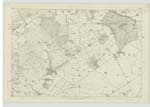OS1/25/17/22
| List of names as written | Various modes of spelling | Authorities for spelling | Situation | Description remarks |
|---|---|---|---|---|
| FORT [Macbeth's Castle] | Macbeth's Castle | Mr. Stewart, Tailor, Kinrossie a member of the antiquarian society The Rev. [Reverend] Mr. Robertson Woodside Wyntoun's Chrons. [Chronicles] of Scotland Old & New Stat. [Statistical] Accounts Shakespeare Pennant's Tour 1772 Mr. Clark Writer, and Factor Mr. Alexander Ritchie Resident Factor |
087 | [Continued] he Mr. Stewart is in the opinion that these buildings were the works of Macbeth, and not of the ancient Britons who never made any choice of material in their erections. In these chambers were found 3 human skeletons sitting in a crouching position with their knees to their chin, also a quern was found. The dotted line across the fort is an entrenchment or excavation made by the late Principal Playfair about 70 years ago, here he found flagstones, charcoal and bones of several species of animals. At the southern end of this line there was found a pit adjoining the rampart full of fat and moist earth, loose stones, burnt wood, and bones of cattle, sheep and hares, but not of the human body. |
Continued entries/extra info
"Last summer, I had an opportunity of examining the excavations made byJohn M Nairne Esqr. on his hill of Dunsinane; and he has been so kind as to allow me to exhibit
the 3 skulls to the Society, that were found in the rude chambers in the hill, I shall avail myself of the opportunity
of stating a few particulars as to what had been previously in excavating this interesting hill and what has
now been accomplished. Dunsinane Hill has been rendered so famous by the genius Shakespere, in the
noblest of his dramas, that it is equally vain for the Antiquarian and historian to allege that Macbeth not
a popular and just prince, during whose reign there was peace and plenty, and that his Castle, as well
as his Cairn, are in Aberdeenshire; the dramatic magician willed it, and Macbeth is considered a treacherous
usurper of the Crown, and a bloody tyrant. The reason of this difference being, that the dramatist did not
confine himself to the accuracy of the historian. Tradition, says Chalmers, relates that Macbeth reigned
17 years, ten of which he spent at Carnbeddie, which the country people call Carnbeth and Macbeth's
Castle. As this is within a few miles of the British fortress upon Dunsinane Hill, in which he probably
sometimes deposited his most valuable effects in times of emergency, it might from this circumstance
have received the name of Macbeth's Castle; particularly as this term is applied in Scotland to Camps or
fortifications, by entrenchments or ramparts. Such an opinion will enable us to explain numerous local
associations. In the Valley of Strathmore near the hill of Dunsinane is an artificial mound of earth named
Transcribers who have contributed to this page.
Trondragirl- Moderator, GMB, Rose
Location information for this page.
Linked mapsheets.




